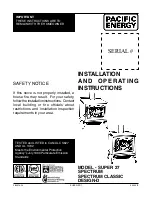
2
Provision for Sweeping
and Cleaning
Adequate provision should be made for
inspecting and cleaning the chimney system.
This is particularly important for solid fuel
applications. Specflue recommends that
chimneys are swept at least once a year.
At the time of sweeping it is important that a
visual inspection of the flue is undertaken.
Combustion Air Requirements
All heating appliances need combustion air to
work efficiently and safely. It is essential that the
appropriate permanent air supply, as required
by the appliance manufacturer and Building
Regulations is provided into the room where the
appliance is situated. Always refer to the appliance
manufacturer’s recommendations and Building
Regulations before installation.
Floor Penetration Components
Where the Specflue DW30 product is used on solid
fuel or oil appliances and the flue gas temperature
exceeds 250°C, the clearance at floor/ceiling void
must be established using the ventilated support
plate and ventilated fire shield, ensuring that no
joints are made within the ceiling void. A magnetic
fire shield cover is also available used in conjunction
with the ventilated fire shield to improve aesthetics.
When connecting to a single wall flue pipe,
Specflue DW30 must project below the appliance
room ceiling by a minimum of 425mm before a
connection is made. All support components
offer a 60mm clearance to combustible material
that must be maintained at all times.
Appliance Connection and
Condensate Removal
The Specflue DW30 adaptor should be used
to facilitate connection from the appliance to
the chimney. It is recommended that the joint
between the adaptor and the appliance/flue pipe
is securely caulked and sealed with fibre rope/
tape and fire sealant. Any flue pipe connection
to the chimney must be made in the same room.
Condensation removal should be determined by
each individual application. The system must be
designed to facilitate future appliance removal.
Note: In the UK, connection to an appliance
which is not connected to the fuel supply,
may be carried out by a competent person.
However, connection to an appliance connected
to the fuel supply must be carried out by an
approved and registered Heating Engineer, e.g.
Gas Safe, HETAS (solid fuel) or OFTEC (oil).
Adjustable Pipes
The Adjustable Pipe consists of two sections which
telescope together. Both sections are insulated, and
the component is supplied with additional insulation,
which will need to be added to the annulus on
site depending on the desired finished length. The
overlapping section should be secured with self
drilling screws. Each end of the adjustable pipe is
secured with locking bands in the normal manner.
The adjustable pipe does not load bear so always
use a wall support or a support plate immediately
above this component when vertically applied.
Handling
The product is relatively easy to handle, but care
should be taken when holding, fitting or assembling
any part of the system. Users are advised to wear
gloves to avoid injury or any sharp exposed edges.
Data Plate
It is a regulatory requirement that a data plate
is to be completed, positioned and secured
by the installer where a hearth, fireplace, flue
or chimney is provided or extended. The data
plate provides essential information regarding
the performance, specification, designation and
installation of the chimney system. The data
plate is to be completed by the installer using an
indelible ink and securely fixed in an unobtrusive
but obvious position. Acceptable fixing positions
would be next to the electricity consumer unit,
water supply stop cock or by the hearth.
Carbon Monoxide Alarm
Approved Document J of the Building
Regulations (Section 2.34) state that all new and
replacement solid fuel appliances must be fitted
with an approved carbon monoxide alarm.




































